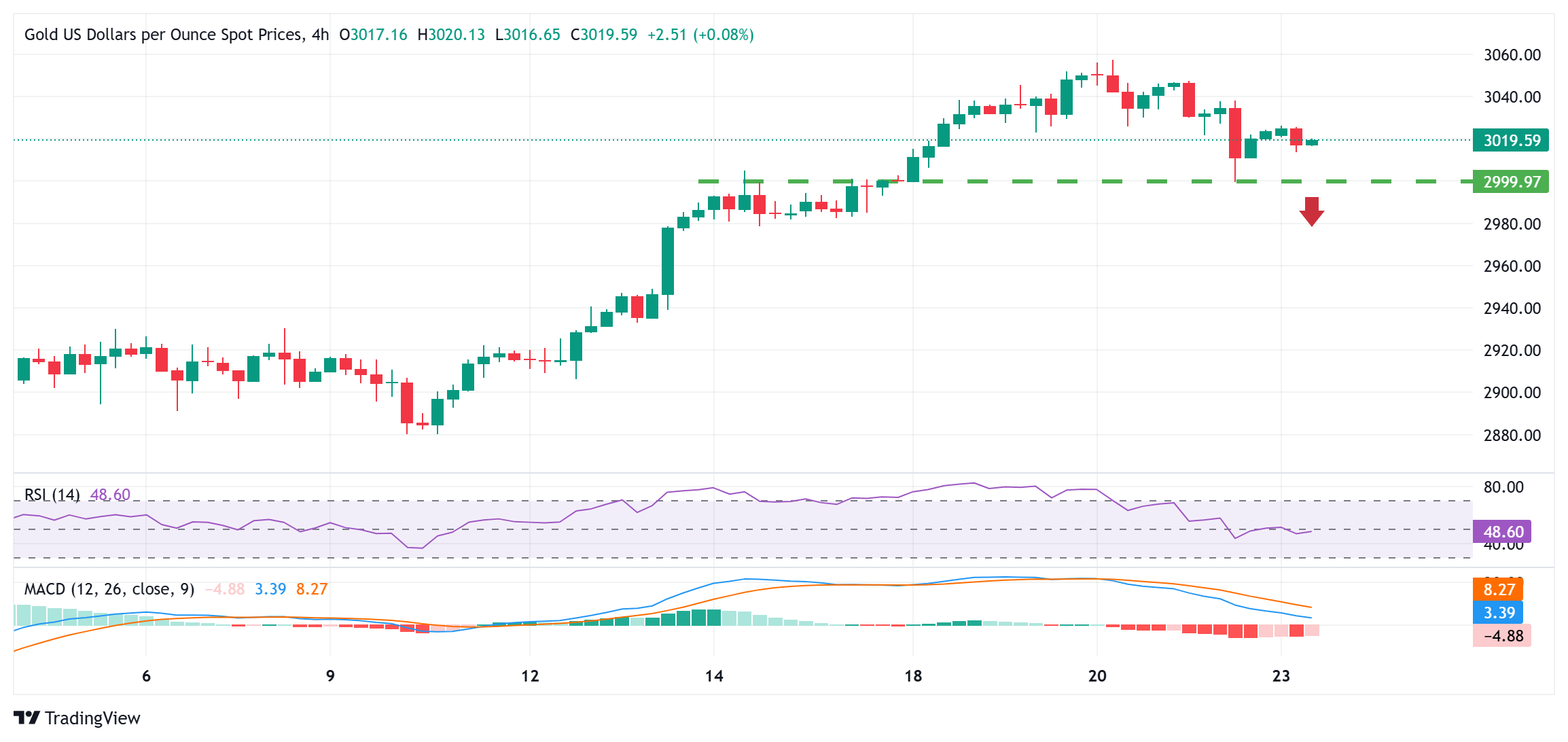Gold price holds steady above $3,000 mark amid softer USD, Fed rate cut bets
- Gold price trades with a negative bias for the third straight day on Monday.
- A positive risk tone undermines demand for the safe-haven precious metal.
- Fed rate cut bets and geopolitical risks lend support to the XAU/USD pair.
Gold price (XAU/USD) remains depressed through the early European session on Monday, though it lacks follow-through selling and holds comfortably above the $3,000 psychological mark or Friday's swing low. The global risk sentiment gets a minor lift in reaction to reports that US President Donald Trump's reciprocal tariffs would be narrower and less strict than initially feared. This is evident from a generally positive tone around the equity markets and turns out to be a key factor undermining the safe-haven precious metal.
Meanwhile, the US Dollar (USD) struggles to capitalize on a three-day-old recovery from a multi-month low amid expectations that a tariff-driven US economic slowdown could force the Federal Reserve (Fed) to resume its rate-cutting cycle soon. This, along with geopolitical risks, acts as a tailwind for the non-yielding Gold price and helps limit the downside. Hence, it will be prudent to wait for strong follow-through selling before confirming that the XAU/USD has topped out in the near term and positioning for any meaningful corrective slide.
Daily Digest Market Movers: Gold price bulls remain on the sidelines amid the upbeat market mood
- Reports over the weekend indicated that US President Donald Trump is planning a narrower, more targeted agenda for the so-called reciprocal tariffs set to take effect on April 2. This, in turn, boosts investors' appetite for riskier assets and undermines the safe-haven Gold price at the start of a new week.
- Delegations from the US have been holding talks with Ukrainian officials as part of peace negotiations and will meet Russian officials on Monday for further talks. Trump and Russian President Vladimir Putin earlier this month agreed on a 30-day pause on Russian strikes on Ukrainian energy facilities.
- The US Dollar held steady near a one-and-half-week high touched on Friday in the wake of the Federal Reserve's less dovish outlook, maintaining its forecast to deliver two 25 basis points rate cuts by the end of this year. This turns out to be another factor weighing on the non-yielding yellow metal.
- Meanwhile, Fed Chair Jerome Powell said last week that tariffs are likely to dampen economic growth. Moreover, traders still see the US central bank lowering borrowing costs at the June, July, and October monetary policy meetings, which keeps a lid on the USD and could support the XAU/USD pair.
- Israel continues with its heavy strikes in Gaza and bombs the largest hospital in the southern region, killing Hamas leader Ismail Barhoum. Meanwhile, Iran-backed Houthis in Yemen fired a ballistic missile at Israel on Sunday, though it was successfully intercepted by Israel's air defense.
- Furthermore, the US military conducted fresh airstrikes on Yemen’s northern province of Saada. Moreover, Houthis claimed to have launched fresh attacks on an aircraft carrier in the Red Sea and the Ben Gurion airport in central Israel, raising the risk of a further escalation of Middle East tensions.
- Traders on Monday will look to the release of flash global PMIs, which would provide fresh insight into the global economic health and provide some impetus to the commodity. The focus, however, will remain on the US Personal Consumption and Expenditure (PCE) Price Index on Friday.
Gold price technical setup supports prospects for the emergence of dip-buyers near the $3,000 mark

From a technical perspective, any subsequent slide might continue to attract some buyers near the $3,000 mark. The said handle should act as a key pivotal point, which if broken decisively might prompt some technical selling and drag the Gold price to the $2,982-2,978 region. The corrective fall could extend further towards the $2,956-2,954 resistance breakpoint, now turned support.
On the flip side, the all-time peak, around the $3,057-3,058 zone touched last week, could act as an immediate hurdle. Given that the daily Relative Strength Index (RSI) has trended lower from the overbought territory, some follow-through buying will be seen as a fresh trigger for bulls. This, in turn, will set the stage for an extension of the recent well-established uptrend witnessed over the past three months or so.
Interest rates FAQs
Interest rates are charged by financial institutions on loans to borrowers and are paid as interest to savers and depositors. They are influenced by base lending rates, which are set by central banks in response to changes in the economy. Central banks normally have a mandate to ensure price stability, which in most cases means targeting a core inflation rate of around 2%. If inflation falls below target the central bank may cut base lending rates, with a view to stimulating lending and boosting the economy. If inflation rises substantially above 2% it normally results in the central bank raising base lending rates in an attempt to lower inflation.
Higher interest rates generally help strengthen a country’s currency as they make it a more attractive place for global investors to park their money.
Higher interest rates overall weigh on the price of Gold because they increase the opportunity cost of holding Gold instead of investing in an interest-bearing asset or placing cash in the bank. If interest rates are high that usually pushes up the price of the US Dollar (USD), and since Gold is priced in Dollars, this has the effect of lowering the price of Gold.
The Fed funds rate is the overnight rate at which US banks lend to each other. It is the oft-quoted headline rate set by the Federal Reserve at its FOMC meetings. It is set as a range, for example 4.75%-5.00%, though the upper limit (in that case 5.00%) is the quoted figure. Market expectations for future Fed funds rate are tracked by the CME FedWatch tool, which shapes how many financial markets behave in anticipation of future Federal Reserve monetary policy decisions.


